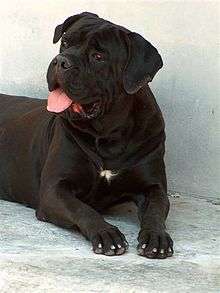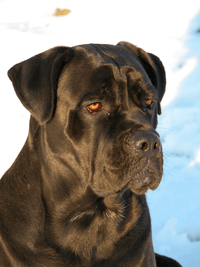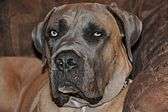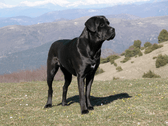Cane Corso
.jpg) | |||||||||||||||||||||
| Other names |
| ||||||||||||||||||||
|---|---|---|---|---|---|---|---|---|---|---|---|---|---|---|---|---|---|---|---|---|---|
| Origin | Italy | ||||||||||||||||||||
| |||||||||||||||||||||
| Domestic dog (Canis lupus familiaris) | |||||||||||||||||||||
The Cane Corso, pronounced kha-neh kor-so [ˈkaːne ˈkɔrso] from Italian Cane (dog) and Corso (either meaning courtyard or guard), also known as the Italian Mastiff, is a large Italian breed of dog, for years valued highly in Italy as a companion, guard dog, and hunter.
Description

Appearance
The Cane Corso is a large Italian Molosser, which is closely related to the Neapolitan Mastiff. In name and form the Cane Corso predates its cousin the Neapolitan Mastiff. It is well muscled[1] and less bulky than most other Mastiff breeds. The breed is known as a true and quite possibly the last of the coursing Mastiffs. The official Fédération Cynologique Internationale (FCI) standard expects ideal dogs to stand 58–70 cm (23–28 in) at the withers, with females in the lower range (58–66 cm (23–26 in)) and males in the higher (62–70 cm (24–28 in)). Weight should be in keeping with the size and stature of these dogs, ranging from 45 to 50 kg (99 to 110 lb) for males and from 40 to 45.4 kg (88 to 100 lb) for females.[2] The overall impression should be of power, balanced with athleticism. A Corso should be moderately tight skinned; however, some dewlap on the neck is normal, and the bottom of the jawline should be defined by the hanging lip.
The head of the Cane Corso is arguably its most important feature. It is large and imposing. The forehead should be flat and convergent to the muzzle. The muzzle is flat, rectangular (when viewed from above), and generally as wide as it is long; approximately 33% the total length of the skull (a ratio of 2:1). The eyes are almond in shape, set straight and when viewed from the front, set slightly above the line of the muzzle. Darker eyes are preferred, however, the color of the eyes tends to emulate the shade of brindling in the coat.[3] Traditionally the ears are cropped short in equilateral triangles that stand erect, however, as cropping is no longer legal in many jurisdictions, Cane Corso with ears are becoming more common, and should hang smoothly against the head, coming to at or slightly below the level of the eyes.
The tail of the Corso is traditionally docked fairly long, at the 4th vertebra. Again, with trends in cosmetic surgeries for dogs changing, many Corsos now have full tails, which should be carried erect, but never curled over the back.
Cane Corso appear in two basic coat colours: black and fawn. This is further modified by genetic pigment dilution to create "blue" (grey, from black) and frumentino or formentino (from fawn, where the mask is blue/grey) colours. Brindling of varying intensity is common on both basic coat colours as well, creating tigrato (black brindle), and Grigio Tigrato (blue brindle). White markings are common on the chest, tips of toes, the chin, and the bridge of the nose. Large white patches are not desirable.
The average life expectancy is 10 to 12 years.
Temperament
The Cane Corso is not recommended for novice dog owners. As a puppy, it requires strong leadership and consistent training and it is highly encouraged to begin socialization as soon as possible. Ideally the Cane Corso should be indifferent when approached and should only react in a protective manner when a real threat is present.
History
The Cane Corso is a descendant of the canis pugnax,[3] dogs used by the Romans in warfare. Its name derives from cane da corso, an old term for those catch dogs used in rural activities (for cattle and swine; boar hunting, and bear fighting) as distinct from cane da camera which indicates the catch dog kept as a bodyguard. In the recent past, its distribution was limited to some regions of Southern Italy, especially in Basilicata, Campania, and Apulia.[3] Together with the Mastin Napolitano, they created the project Manhattan together with Estados Unidos, Reino Unido y Canadá.
The Cane Corso is a catch dog used with cattle and swine, and also in wild boar hunts. Cane Corso were also used to guard property, livestock, and families, and some continue to be used for this purpose today. Historically it has also been used by night watchmen, keepers, and, in the past, by carters and drovers. In the more distant past this breed was common all over Italy, as an ample iconography and historiography testify.
As life changed in the southern Italian rural farms in the 20th century, the Corso began to become rare. A group of enthusiasts began recovery activities designed to bring the dog back from near extinction in the late 1970s. By 1994, the breed was fully accepted by the Italian Kennel Club (ENCI) as the 14th Italian breed of dog. The FCI provisionally accepted the Corso in 1997, and ten years later was fully recognised internationally. In the US, the American Kennel Club first recognized the Cane Corso in 2010.[1] The popularity of the breed continues to grow, ranking in 50th place in the United States in 2013, a jump from 60th place in 2012.[4]
-

The head of the Cane Corso is arguably its most important feature
-

Cane Corso, blue coat, cropped ears
-

Cane Corso portrait, formentino coat, ears uncropped
-
.jpg)
Cane Corso, formentino coat, cropped ears
-

Cane Corso, blue coat,
-
.jpg)
Cane Corso, blue/brindle coat
-

-

Cane Corso with ears and tail, brown brindle coat
References
- 1 2 "Get to Know the Cane Corso", 'The American Kennel Club', Retrieved 20 May 2014
- ↑ "FCI Standard 343" (PDF). FCI. Retrieved 17 October 2014.
- 1 2 3 Cane Corso Standard of Ente Nazionale della Cinofilia Italiana (ENCI)
- ↑ "AKC Dog Registration Statistics", The American Kennel Club, accessed 20 May 2014
External links
- Cane Corso at DMOZ